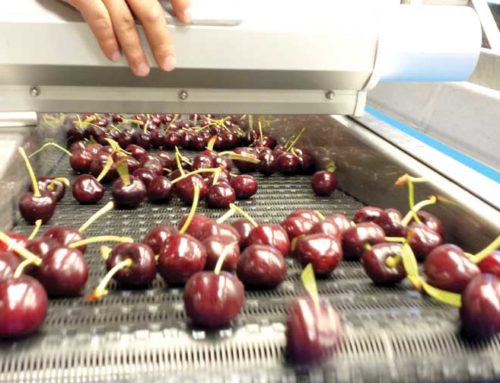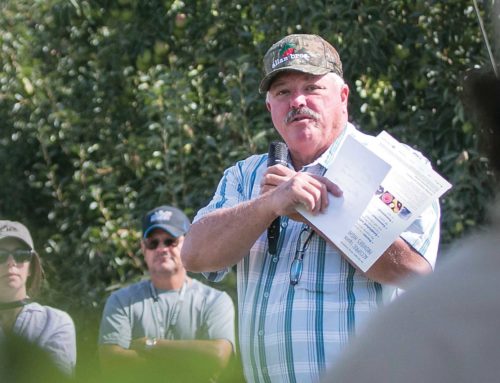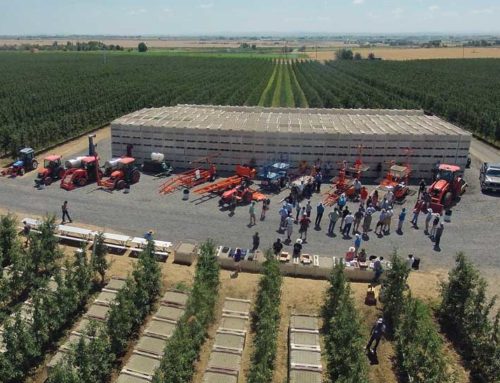
Fabric row covers placed over the soil in the tree rows can have numerous benefits in cherry orchards, research shows. Those benefits include easier weed control, moisture conservation, increased tree growth and branching, higher fruit yields, and better fruit quality. Dr. Roberto Nuñez-Elisea, horticulturist with Oregon State University at Hood River, has been testing the covers in a three-acre test plot at the Mid-Columbia Agricultural Research and Extension Center. The trees, which were planted in 2000, are Regina cherries on Gisela 6 rootstocks, trained to a central leader system. The fabric is eight feet wide and covers the entire tree row.
A low-volume microsprinkler irrigation system is used. Nuñez said the temperature of the soil at 2 and 4 inches below the ground is only 3 to 4°F higher in the covered rows than in the uncovered rows, and no increase was detected at lower levels. The trunk cross-sectional area was significantly larger in the covered trees. Although the covered trees had about the same number of large branches, they had many more young shoots, and more wood had to be removed during pruning.
Results in 2004 show that, on average, the prunings from covered trees weighed twice as much as those from the control trees. However, the increased weight of the wood did not translate to twice as much work during pruning, he added. Weed control proved to be more time-consuming in the uncovered rows. Yields in 2004 were 16 pounds of cherries per tree from the covered rows compared with only 7 pounds from the uncovered trees. The cherries from the covered trees were 10 percent larger, and 11 percent firmer.
However, the Brix level was 6 percent lower. Nuñez attributed the lower soluble solids level to a delay of two to three days in fruit maturity in the covered rows, possibly caused by shading from the more vigorous growth and the heavier crop load. Nuñez said he thinks the higher temperatures, water conservation, and improved weed control must be factors in promoting root growth and function. Foliar nitrogen was significantly higher in the covered rows.
“We’re interested in learning more about how these root covers affect root distribution and density,” he said.
Economics
Economics The cost of buying and installing the cover is $2,140 per acre. When it’s used in a new orchard, it increases establishment costs significantly. However, because of higher, early yields, a planting with covered rows will reach the breakeven point two years sooner than a planting with uncovered rows. However, there are some concerns. Nuñez believes researchers don’t yet know what the long-term effect will be on soil biology, though so far there have been no problems. Applying fertilizer is tricky. Fertilizer can permeate through the cover, but might not do so on slopes.
Solutions
Excessive tree vigor might need to be addressed through wider tree spacing, more dwarfing rootstocks, or deficit irrigation. There is also the potential for rodents to nest under the covers, though Nuñez said that hadn’t happened in the test plot. He now plans to test overtree covers with both covered and uncovered tree rows in an attempt to protect the trees from excessive heat, light, rain, wind, and birds. He is also testing other types of row covers, such as organic mulches, and will look at different ways of scheduling irrigation.






Leave A Comment